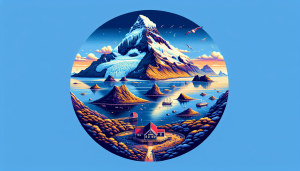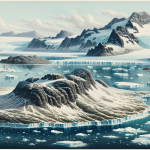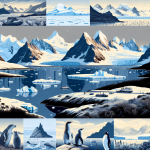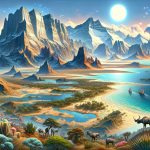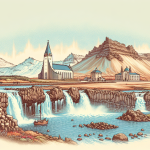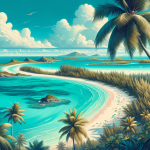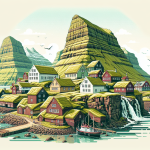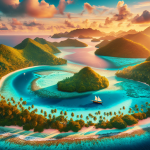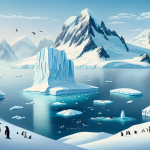Exploring the Untouched Wonders of Heard Island and McDonald Islands
Heard Island and McDonald Islands are two of the most remote and least visited places on Earth, making them a unique destination for those with a spirit of adventure and a love for untouched natural beauty. Located in the southern Indian Ocean, these islands are Australian external territories and are known for their stunning landscapes, diverse wildlife, and significant geological features. Heard Island is home to Big Ben, an active volcano that even features a glacier, while McDonald Islands are known for their rugged terrain and sparse vegetation. This article delves into the unique aspects of these islands, exploring their natural wonders, the challenges of visiting, and the efforts to preserve their pristine environment.
The Geographical Marvels of Heard Island and McDonald Islands
Volcanic Landscapes
One of the most striking features of Heard Island is its volcanic landscape. Big Ben, the island’s highest peak, rises to 2,745 meters and is an active volcano. The presence of glaciers on an active volcano is rare and adds to the island’s unique geological significance. Visitors can witness steaming fumaroles and recent lava flows, making Heard Island a living laboratory for studying volcanic activity in a sub-Antarctic environment.
Glaciers and Ice Formations
Heard Island’s glaciers are another highlight. Covering more than 80% of the island, these glaciers are constantly shifting and changing, offering a dynamic and ever-evolving landscape. The Brown Glacier and the Gotley Glacier are among the most prominent, providing a stark contrast to the volcanic terrain. These glaciers contribute to the island’s rugged beauty and are a critical habitat for various wildlife species.
Unique Flora and Fauna
Despite the harsh conditions, Heard Island and McDonald Islands boast a surprising diversity of life. The islands are home to several species of seals, including the Southern Elephant Seal and the Antarctic Fur Seal. Birdlife is also abundant, with species such as the Heard Island Shag, the Black-browed Albatross, and the King Penguin making the islands their home. The unique flora includes hardy plants like mosses, liverworts, and lichens that thrive in the harsh, windy environment.
Challenges of Visiting Heard Island and McDonald Islands
Accessibility
Reaching Heard Island and McDonald Islands is no small feat. The islands are located more than 4,000 kilometers southwest of Australia and are only accessible by sea. The journey can take several weeks, and the turbulent Southern Ocean presents significant challenges for even the most experienced sailors. There are no permanent human inhabitants, and the islands lack any infrastructure, making self-sufficiency essential for any expedition.
Weather Conditions
The weather on Heard Island and McDonald Islands is notoriously unpredictable and harsh. Strong winds, frequent storms, and low temperatures are the norm. These conditions can make landings difficult and limit the time visitors can spend on the islands. Proper preparation, including specialized gear and clothing, is crucial for anyone planning a visit.
Environmental Regulations
As a protected area, Heard Island and McDonald Islands are subject to strict environmental regulations. The Australian government has implemented measures to preserve the islands’ pristine condition, including restrictions on the number of visitors and activities allowed. All expeditions must obtain the necessary permits and follow guidelines to minimize their impact on the delicate ecosystem.
Preservation Efforts and Scientific Research
Conservation Measures
Heard Island and McDonald Islands are recognized as a World Heritage Site, highlighting their global importance. The Australian government, along with various international organizations, has put in place comprehensive conservation measures to protect the islands’ unique environment. These efforts include monitoring wildlife populations, controlling invasive species, and conducting regular environmental assessments.
Scientific Research
The remote and pristine nature of Heard Island and McDonald Islands makes them an ideal location for scientific research. Scientists from around the world study the islands’ geology, climate, and ecosystems to gain insights into broader environmental processes. Research on volcanic activity, glacier dynamics, and wildlife populations contributes to our understanding of these critical areas and informs global conservation efforts.
Climate Change Impact
As with many remote and fragile ecosystems, Heard Island and McDonald Islands are not immune to the impacts of climate change. Rising temperatures and changing weather patterns threaten the islands’ glaciers and wildlife habitats. Ongoing research aims to understand these changes and develop strategies to mitigate their effects, ensuring the islands remain a sanctuary for future generations.
The Allure of the Untouched Wilderness
Adventure Tourism
For those willing to brave the challenges, Heard Island and McDonald Islands offer an unparalleled adventure. The opportunity to explore one of the last untouched wildernesses on Earth attracts a select group of adventurous travelers. From mountaineering on Big Ben to observing the unique wildlife, the islands provide a once-in-a-lifetime experience for those seeking to connect with nature in its purest form.
Photography Opportunities
The stunning landscapes and unique wildlife of Heard Island and McDonald Islands make them a paradise for photographers. The contrast between the volcanic terrain, glaciers, and diverse fauna offers endless opportunities for capturing striking images. Photographers can document the raw beauty of the islands and share their experiences with a wider audience, raising awareness about the importance of preserving these remote locations.
Personal Reflection and Connection
Visiting Heard Island and McDonald Islands is not just about adventure; it’s also an opportunity for personal reflection and connection with nature. The isolation and untouched environment provide a rare chance to disconnect from the modern world and immerse oneself in the natural world. This experience can be transformative, fostering a deeper appreciation for the planet’s beauty and the need to protect its most fragile ecosystems.
Practical Information for Potential Visitors
Planning Your Visit
Given the remote location and challenging conditions, extensive planning is essential for any visit to Heard Island and McDonald Islands. Potential visitors must arrange for transportation, secure necessary permits, and prepare for self-sufficiency during their stay. Working with experienced expedition companies can help ensure a safe and successful journey.
Safety Considerations
Safety is a paramount concern when visiting such remote and inhospitable locations. Proper gear, including cold-weather clothing, navigation equipment, and emergency supplies, is essential. Visitors must be prepared for the unpredictable weather and potential hazards associated with volcanic activity and glacial terrain.
Respecting the Environment
Respecting the environment is crucial when visiting Heard Island and McDonald Islands. Visitors must adhere to all regulations and guidelines to minimize their impact on the delicate ecosystem. This includes proper waste disposal, avoiding disturbance of wildlife, and following designated paths and areas.
Conclusion
Heard Island and McDonald Islands offer a rare and unparalleled opportunity to explore one of the last untouched wildernesses on Earth. With their stunning volcanic landscapes, dynamic glaciers, and diverse wildlife, these islands are a testament to the planet’s natural beauty and resilience. While the journey to reach them is challenging, the rewards are immense, providing a unique and transformative experience for those who venture to these remote corners of the world. By respecting and preserving these pristine environments, we can ensure that Heard Island and McDonald Islands remain a sanctuary for future generations to discover and cherish.
For more information on planning your adventure to these incredible islands, visit the Australian Antarctic Division.
